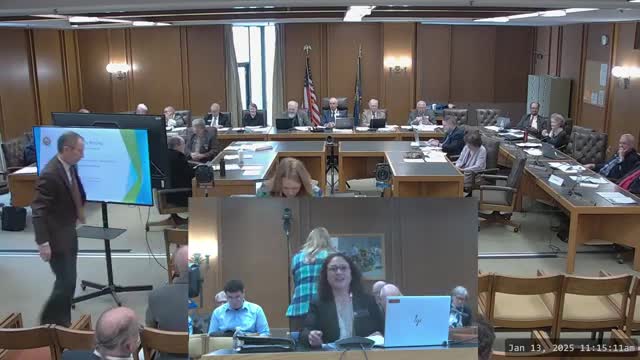Treasurer reports $1.7B cash, upgraded credit ratings and $292M stabilization account; warns FY25 revenues lower than plan
January 13, 2025 | Ways and Means, House of Representatives, Committees , Legislative, New Hampshire
This article was created by AI summarizing key points discussed. AI makes mistakes, so for full details and context, please refer to the video of the full meeting. Please report any errors so we can fix them. Report an error »

Lede: State Treasurer Monica Massapelli briefed the Ways and Means committee on the state’s cash position, credit ratings and debt profile, emphasizing that although FY25 revenues were tracking below plan the state retained substantial cash and reserves that support its investment grade ratings.
Nut graf: Massapelli said operating cash that peaked near $2.8 billion in FY24 had declined to roughly $1.7 billion at the time of her briefing, and she flagged a projected $80 million in preliminary lapse shortfalls and slower interest income as ARPA dollars are spent down. She emphasized the revenue stabilization account (the rainy day fund) totaled about $292.5 million and that ratings agencies had upgraded the state (S&P to double A+ with a stable outlook), noting the state’s debt ratios remained below median peers.
Body: The treasurer listed the strengths that supported the upgrade: a diversified economy, disciplined financial management, strong cash reserves and relatively low debt. She noted the Education Trust Fund outperformance in recent years and explained short‑term risks: FY24–25 revenues are coming in lower than plan while expenditures were modestly higher than trends. She said investment income contributed meaningfully to the general fund in FY23–24 (e.g., tens of millions) but projected interest income would decline over FY26–27 as ARPA balances are spent.
Massapelli described the revenue stabilization account (RSA) — the “rainy day fund” — at about $292.5 million and said the statutory maximum would be roughly 10% of prior biennium revenues (about $400 million by their calculation). She said S&P upgraded the state and assigned a stable outlook, and that Moody’s and Fitch had strong ratings as well, but noted reaching triple‑A would likely require larger reserves.
On debt, Massapelli said New Hampshire’s net tax‑supported debt has declined and projected borrowing plans in the near term put the state well below median peer leverage ratios. She cautioned that new authorizations would increase fixed debt service costs and urged attention to long‑term affordability.
Ending: The treasurer urged the committees to watch January–March revenue performance, prepare for lower interest income ahead, and view the rainy day fund as the primary tool if shortfalls materialize; she said the Treasury would continue to brief the legislature on cash and investment income performance.
Nut graf: Massapelli said operating cash that peaked near $2.8 billion in FY24 had declined to roughly $1.7 billion at the time of her briefing, and she flagged a projected $80 million in preliminary lapse shortfalls and slower interest income as ARPA dollars are spent down. She emphasized the revenue stabilization account (the rainy day fund) totaled about $292.5 million and that ratings agencies had upgraded the state (S&P to double A+ with a stable outlook), noting the state’s debt ratios remained below median peers.
Body: The treasurer listed the strengths that supported the upgrade: a diversified economy, disciplined financial management, strong cash reserves and relatively low debt. She noted the Education Trust Fund outperformance in recent years and explained short‑term risks: FY24–25 revenues are coming in lower than plan while expenditures were modestly higher than trends. She said investment income contributed meaningfully to the general fund in FY23–24 (e.g., tens of millions) but projected interest income would decline over FY26–27 as ARPA balances are spent.
Massapelli described the revenue stabilization account (RSA) — the “rainy day fund” — at about $292.5 million and said the statutory maximum would be roughly 10% of prior biennium revenues (about $400 million by their calculation). She said S&P upgraded the state and assigned a stable outlook, and that Moody’s and Fitch had strong ratings as well, but noted reaching triple‑A would likely require larger reserves.
On debt, Massapelli said New Hampshire’s net tax‑supported debt has declined and projected borrowing plans in the near term put the state well below median peer leverage ratios. She cautioned that new authorizations would increase fixed debt service costs and urged attention to long‑term affordability.
Ending: The treasurer urged the committees to watch January–March revenue performance, prepare for lower interest income ahead, and view the rainy day fund as the primary tool if shortfalls materialize; she said the Treasury would continue to brief the legislature on cash and investment income performance.
View full meeting
This article is based on a recent meeting—watch the full video and explore the complete transcript for deeper insights into the discussion.
View full meeting
